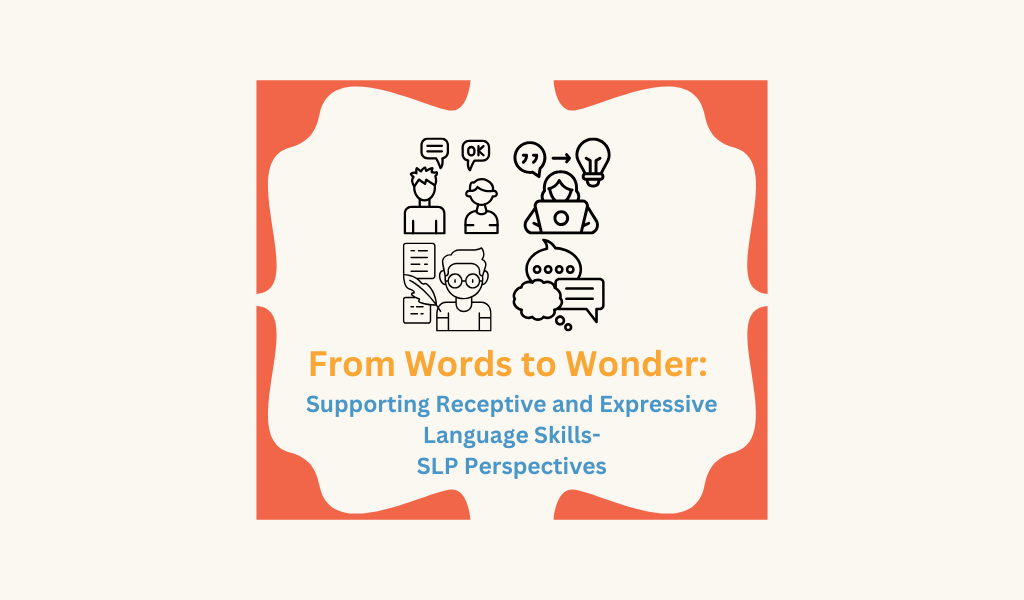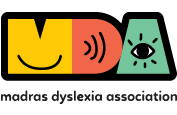
From Words to Wonder: Supporting Receptive and Expressive Language Skills- SLP Perspectives
Co-morbidities with SLD
By Ms. Sushmitha Murali Speech Language Pathologist Ph.D. Scholar, SRFASLP, SRIHER sushmithaslpa@gmail.com

Language is essential for communication, learning, and social interaction. For children with dyslexia and other language-based learning differences, challenges with receptive and expressive language can be significant, yet often misunderstood. Understanding these two facets of language is crucial to provide appropriate support.
Language disorder can be defined as persistent language problems that can negatively affect social and educational aspects of an individual’s life (So & To, 2022). It refers to impairment in the comprehension or use of spoken, written, or other symbol systems. It may involve difficulties in:
- Form: Phonology (speech sounds), morphology (structure of words), and syntax (grammatical sentence structure).
- Content: Semantics, or the meaning and vocabulary of language.
- Use: Pragmatics, or language in social contexts.
This framework, established by Bloom and Lahey (1978) and Lahey (1988), continues to guide understanding and interventions for language challenges.
Receptive Language and Expressive Language
- Receptive Language is the ability to understand and process spoken or written language. This includes understanding vocabulary, following instructions, and interpreting grammatical structures.
- Expressive Language involves using words, sentences, gestures, or writing to communicate thoughts and ideas. It requires structuring sentences, vocabulary selection, and organizing thoughts coherently.
Children with dyslexia may experience difficulties in one or both areas, affecting their academic performance and social interactions.
Signs of Receptive Language Challenges
- Have difficulty following multi-step commands.
- Frequently ask for repetition or clarification.
- Struggle to grasp the meaning of new words or complex sentences.
- Having difficulty interpreting complex questions or directions.
- Show delayed responses during conversations or in classroom settings.
Signs of Expressive Language Challenges
- Have a limited vocabulary compared to peers.
- Struggle to form grammatically correct sentences.
- Use filler words (e.g., “um”) or pause frequently when speaking.
- Find it hard to narrate events or stories sequentially.
- Avoid speaking in class or participating in discussions.
Impact on Academic and Social Life
Receptive and expressive language challenges can lead to academic struggles, particularly in reading, writing, and comprehension tasks. Socially, these difficulties may cause frustration, low self-esteem, or withdrawal, as children might feel misunderstood or unable to express themselves effectively.
Strategies to Support Receptive Language Development
- Simplify Instructions
Breakdown instructions into simple, comprehendible steps using concise language
- Encourage Active Listening
Engage children in listening activities like storytelling or games requiring them to follow instructions.
- Visual Supports
Reinforce spoken instructions with visuals like flashcards, charts, or gestures to link words to actions or objects.
- Pre-teach Vocabulary
Introduce and discuss new words in advance to build familiarity.
- Repeat and Rephrase
Restate or rephrase sentences wherever necessary to help children better process and understand language.
Strategies to Support Expressive Language Development
- Model Language Use
Demonstrate correct sentence structure and vocabulary by speaking slowly and clearly. Provide structured, interactive examples for children to listen to and learn.
- Encourage Story Telling/ Narration of events
Ask children to share stories or describe activities; provide prompts to guide them if needed.
- Expand Sentences
If a child uses a short sentence, expand on it. For example, if the child says, “Dog runs,” respond with “Yes, the dog is running fast in the park.”
- Use Role-Playing Games
Engage in pretend play that involves conversation and dialogues to develop communication skills.
- Provide Choices
Encourage verbal responses by offering options, e.g., “Do you want to play with blocks or draw?”
- Self-talk and Parallel talk
Describe your own actions, such as saying, “I’m building with blocks,” (self-talk), or narrate the child’s actions as they play (parallel-talk). These techniques demonstrate how to connect actions with language.
- Extensions
Add semantic details to the child’s remarks. For example, if a child shows a car, say, “You have the blue car with big black wheels.”
- Build up and breakdown
Show sentence structure by breaking sentences into smaller parts and then rebuilding them.
Role of Educators and Therapists
Teachers and speech-language pathologists play a crucial role in addressing language challenges. A language-rich classroom environment, along with tailored interventions, can make a significant difference. Therapy sessions focusing on specific language goals can help children improve their communication.
Parental Involvement
Parents are central to fostering language development. Reading aloud, engaging in conversations, and playing language-based games at home can reinforce the skills children learn in school or therapy. Encourage patience and positivity, as children need time and consistent support to build confidence.
When to Seek Professional Help?
If a child exhibits persistent difficulties with understanding or expressing language, consulting a speech-language pathologist is essential. Early intervention can significantly improve outcomes and help children excel academically and socially.
Building a Supportive Environment
Creating an environment where children feel safe to express themselves is important. Celebrate small victories in communication and encourage consistent practice. Be attentive to their frustrations and offer reassurance to boost their confidence.
